TELL ME About It: AAC Learning with ‘Come Out and Play, Little Mouse’
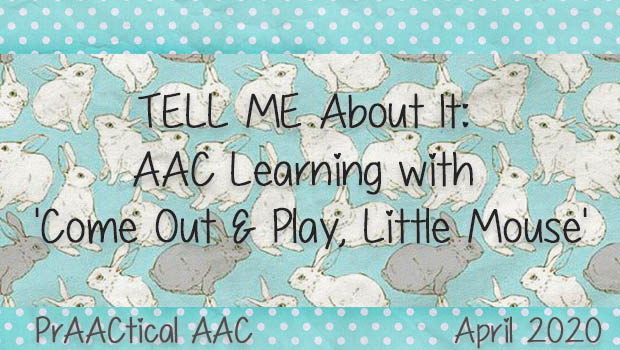
 It’s time for another edition of the TELL ME About It series which focuses on AAC, language, and literacy learning with preschool children. Maggie Judson and Jeanna Antrim are back with more great ideas for AAC intervention, this time focusing on the book, Come Out and Play, Little Mouse.
It’s time for another edition of the TELL ME About It series which focuses on AAC, language, and literacy learning with preschool children. Maggie Judson and Jeanna Antrim are back with more great ideas for AAC intervention, this time focusing on the book, Come Out and Play, Little Mouse.
Maggie and Jeanna are speech-language pathologists who work in the Assistive Technology Department for the Belleville Area Special Services Cooperative (BASSC) in central Illinois. They are AT/AAC facilitators and provide evaluations, direct therapy, consultations, and trainings.
You can check out the earlier posts in this series below.
- No, David
- Go Away Big Green Monster
- What Do You Like?
- Here Are My Hands
- From Head to Toe
- I Went Walking
- Brown Bear, Brown Bear
- TELL ME AAC Literacy Kits
Be sure to see their videos modeling book reading with two AAC systems toward the end of this post.
TELL ME About It: AAC Learning with ‘Come Out and Play, Little Mouse’!
TELL ME About Reading: The eighth book in the TELL ME program (Teaching Early Language and Literacy through Multimodal Expression) is “Come Out and Play, Little Mouse.” An excellent book for introducing a simple plot line to our students, while still providing repetitive exposure to those oh-so-awesome core words. Connecting the story to background knowledge is very natural for this book, as the story takes place within the home. Plus, there are a lot of interactions with family members and a lot of talk about chores that need to get done! Another fun aspect of this book is the illustrations! The pictures are very colorful and detailed, which provides for a variety of communication opportunities during the picture walk-throughs and repeated readings you will be providing.
See below for the rest of the book focus for “Come Out and Play, Little Mouse”:
Book Focus: Come Out and Play, Little Mouse
- Core Words (BOW-WOW Words): BUSY, FATHER, LITTLE, MOTHER
- Additional Words (Tiger Talk Words): brother, later, sister, today
- Concept Vocabulary: days of the week and other time concept vocabulary
- Special Letter: n
- Book Concept: Title
TELL ME About Writing:
Predictable chart writing is an excellent way of providing writing instruction to our students who demonstrate emergent literacy abilities. The activities that are part of the process of predictable chart writing supports students to demonstrate writing and develop different concepts of print. And bonus! With predictable chart writing, “students engage more readily in the learning process because the content is personalized to their interests and experiences, and they stay engaged because every day they are doing something different with the text” (Erickson, K., & Koppenhaver, D., 2020, p. 79)!
Today’s writing activities are described below:
- Before Writing: Review those story core words – BUSY, FATHER, LITTLE, MOTHER – with say-and-repeat! Say the words one at a time while holding up a word or symbol card, supporting students to repeat the words. And don’t forget those additional target words. aka Tiger Talk Words! For students working on these words – brother, later, sister, today – provide aided language input by pointing to them on the AAC system while at the same time saying the word. Then, review the title of the chart before moving on to the next part of the lesson!
- Writing: Today’s writing lesson has us clapping out the words in each sentence. We have found that students love this activity, because movement! Have students who are not able to or do not want to clap? No problem! Support them to follow along in a different way, such as by:
- stomping their foot
- tapping the table
- or by reminding them to listen to and read the words in their head
The focus is on participation that allows students the opportunity to practice the skill of listening for individual words in reading.
To finish up this part of the lesson, use the chart to go on a core word and special letter hunt. As students find the targets, highlight and talk about them. This provides additional opportunity to practice print concepts, along with providing more core word practice. Hello there repeated exposure!
3. After Writing: To finish up the writing lesson, sing the letter song for the special letter ‘n’ and then do another movement activity! Today’s letter activity is ‘Letter On The Floor.’ Use masking tape to make a giant letter ‘N’ on the floor. Allow students to walk the tape saying, “make the letter ‘N’ with your feet!”. Students love this activity because, again, movement! Pair that with how low prep it is, and we bet you will be putting this activity into heavy rotation! 
TELL ME More: Below are some specific ideas on how to implement “Come Out and Play, Little Mouse” in your therapy sessions and classrooms TELL ME-style!
- Activity – Story Retelling!
Story retelling is a great extension activity to work on after shared reading! It addresses story comprehension skills, language and communication skills, and, ultimately, a student’s ability to sequence and retell events that happen in their own lives.
“Come Out and Play, Little Mouse” is a great book to work on story retelling skills because the book has a strong plotline, with a problem and solution, and a beginning, middle, and end. Students in the preschool and early childhood special education classroom may benefit from using pictures or props to work on story retelling. These visuals provide the necessary support to recall characters and events in the book as they sequence the plot and retell the story. An easy way to provide such support is with picture story props! 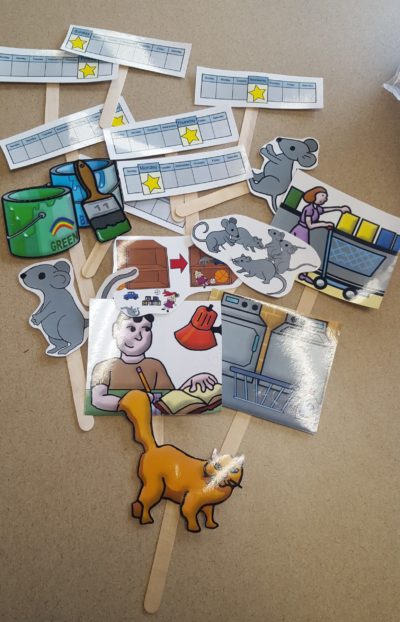
Students can manipulate and organize the pictures to work on ordering the events of the story and retell the story. Yay for visuals!
- Teaching Strategy – Communication Temptations!
We, as adults, do not typically want to communicate, exchange information, and interact when we are not engaged, motivated, or having fun. Our students feel the same way! When we turn communication into a drill or activity to check off a schedule, it can really take the motivation out of communicating to connect. Here are some ideas to try out to up the communication temptations in the classroom!
- Rotate toys and center activities – keep it fresh, motivating students to talk about something new.
- Don’t have all options available all the time – keep some of the fun toys back in a container or bag, allowing students the opportunity to communicate for them.
- Store preferred items in clear containers or slightly out of reach – an oldie but a goodie strategy!
- Provide opportunities to allow students to engage with peers and preferred staff members – this can be such a powerful temptation to increase student motivation to communicate for real reasons!
- Implementation Tip – Story Props!
Who doesn’t love story props?! Story props and toys can help students make connections to the book and support engagement and interaction during shared reading activities. We have pictures of characters and objects from the story velcroed on craft sticks for students to interact with during reading to help increase motivation and interest and to support comprehension. And as discussed earlier, they also double as visual supports during story retelling activities. Even better, they allow students to become a part of the story by providing them the opportunity to manipulate story elements!
Also, they are fun! You can easily use them on repeat in lots of different, fun ways to quickly work in book learning throughout the day! Add them to a sensory bin. Hide them around the room to go on a “story elements” hunt. Use them to create story webs on the fly. 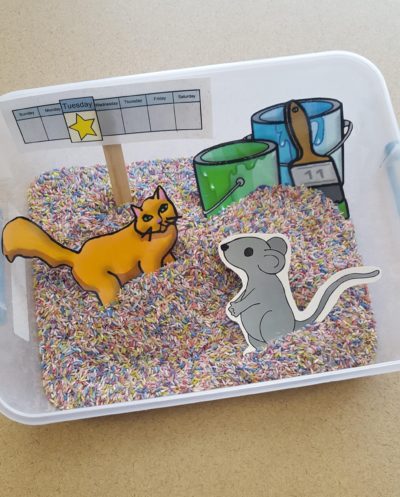

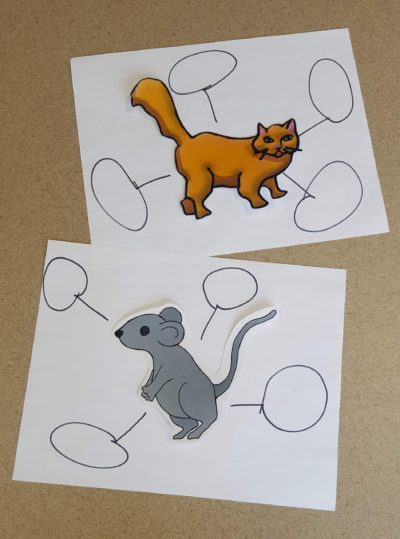
We can’t get enough of our story props and love them so much that we have prepped a set for each book in the TELL ME series!
- Aided Language Input Tip – Hold the Point!
When providing aided language input, keep in mind that when you touch a symbol on the AAC system, you want to hold the point. This gives students time to see the point, which draws attention to the word. And to work on eliciting a good, isolated, direct selection from our students, we need to use a steady point on the icon vs. a tapping motion. As best said by Gail Van Tatenhove, “A BIG DON’T when modeling is that you are not BOUNCING or TAP TAP TAPPING on the word as you model it. That can result in the student copying exactly what he sees you doing – and he may also tap tap tap or bounce bounce bounce on words when he is using the AAC system (Van Tatenhove, G & PaTTAN, module 7, slide 12).”
Often, we have found that we tap on the symbol as a way to try and get student attention. However, if our students then imitate that tap, it can significantly interfere with direct selection. A better way to gain attention to our aided language input is to skip the tap-tap-tap and instead just keep our finger on the symbol. So remember, hold that steady point! 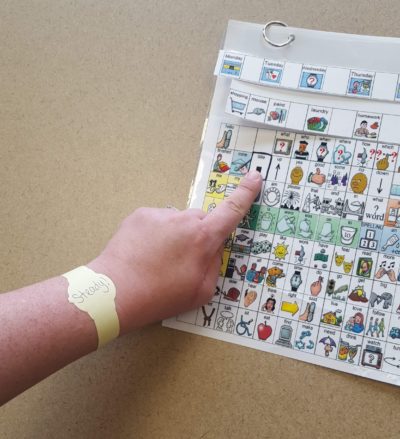
- Goal Ideas – Providing shared reading and writing opportunities directly relates to IEP goals, as these activities align with various core standards. Here are some examples you may find applicable:
- ELA-Literacy.RL.K.2 – With prompting and support, retell familiar stories, including key details.
- ELA-Literacy.RL.K.3 – With prompting and support, identify characters, settings, and major events in a story.
———————————————————————————————————————
To read more about how we prepare for a TELL ME week, check out the initial post in the TELL ME About It series here.
Check out the videos of us reading the book “Come Out and Play, Little Mouse” while providing aided language input.
Direct Link to Video -=https://www.youtube.com/watch?v=oHWcdyoelvs
LAMP Words for Life Vocabulary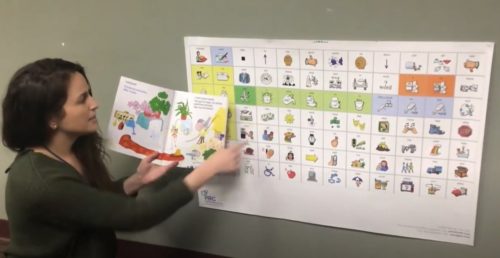
Direct Link to Video – https://www.youtube.com/watch?v=oKduGDOd1kk
Be sure to check back next month as we work through the TELL ME manual and share activities, teaching strategies and implementation tips for the next book in the program, “Lunch Box Surprise”!
RESOURCES and REFERENCES:
- Erickson, K,. & Koppenhaver, D. (2020). Comprehensive Literacy for All: Teaching Students with Significant Disabilities to Read and Write. Baltimore, MA: Paul H. Brookes Publishing Co.
- Van Tatenhove, G & PaTTAN. (2016). Practice Partner Skills, Module 7 (PowerPoint Slides). Retrieved from https://www.pattan.net/videos/poweraac-module-7-practice-partner-skill
- You can purchase the TELL ME manual from the Attainment Company or from ASHA.
- You can learn more about the program by watching the webinar TELL ME: AAC for the Preschool Classroom presented by Dr. Carole Zangari, available from Saltillo (bit.ly/2RNpykn).
You can find our Lesson Planning form for “Come Out and Play, Little Mouse” and a blank form here.
Follow us on Instagram @basscAAC and subscribe to our YouTube channel (basscAAC) for more AAC implementation ideas!
Filed under: Featured Posts, PrAACtical Thinking
Tagged With: core vocabulary, reading, TELL ME
This post was written by Carole Zangari
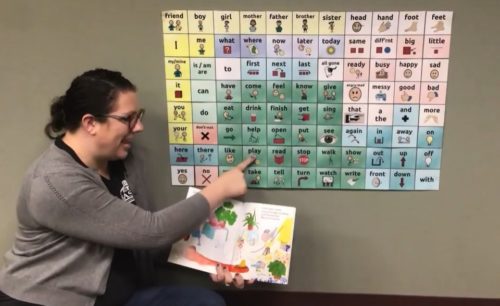


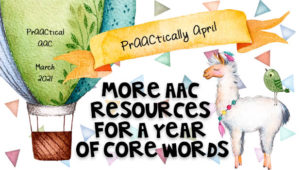
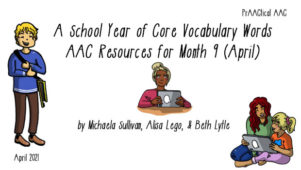

1 Comment
These posts are SO helpful for teachers implementing Tell Me AND for everyone else just needed real world examples peppered with good implementation tips. I think I’ll just save all of these in a file to send out to our preschool teachers!! Thanks so much for ALL the work on these!